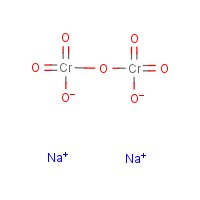Sodium dichromate
Agent Name
Sodium dichromate
CAS Number
10588-01-9
Formula
Cr2-O7.2Na
Major Category
Metals

Synonyms
Bichromate de sodium [French]; Bichromate of soda; Celcure; Celcure Wood Presrvative; Chromic acid (H2Cr2O7), disodium salt; Chromium sodium oxide (Cr2Na2O7); Dichromic acid (H2Cr2O7), disodium salt; Disodium dichromate; Koppers Wolman Salts CCA; Natriumbichromaat [Dutch]; Natriumdichromaat [Dutch]; Natriumdichromat [German]; Oakite Composition No. 155; Osmose Hollow Heart Concentrate; Sodio (dicromato di) [Italian]; Sodium bichromate; Sodium dichromate (Na2(Cr2O7)); Sodium dichromate(VI); Sodium(dichromate de) [French]; Wolman Salts CCA-Type B; Wolman Salts CCA-Type C; Wood Cure A Wood Preservative; [ChemIDplus] Anhydrous sodium dichromate; [Ullmann] UN3086
Category
Chromium Compounds, Inorganic
Description
Red to orange hygroscopic solid; Soluble in water; [ICSC] Dark red aqueous solution; Deliquescent; [CAMEO]
Sources/Uses
Used in water treatment, dye and electric battery manufacturing, bleaching (fats, oils, sponges, and resins), refining petroleum, corrosion inhibitors (paints, metal coatings, and water systems), metal treatments, electroengraving of copper, defoliation of cotton and other plants and shrubs, fungicides, insecticides, miticides, wood preservation, glass colorants, dye mordants, and breweries (algaecide); [HSDB] Used in colorimetry (copper determination), as a complexing agent, and as an oxidation inhibitor in ethyl ether; [Hawley] Used to make vitamin K and waxes; [eChemPortal: ESIS: RAR] Compared with sodium dichromate dihydrate, it has the advantage of first absorbing 2 molecules of water instead of deliquescing immediately; [Ullmann]
Comments
A corrosive substance that can cause injury to the skin, eyes, and respiratory tract; Can be absorbed through skin; May cause skin sensitization and asthma after prolonged contact; May cause kidney and liver injury; May cause perforated nasal septum; [ICSC] A skin and eye irritant; Can cause asthma-like respiratory irritation; A powerful oxidizing agent; [HSDB] Corrosive to skin and eyes; May cause skin and respiratory sensitization after prolonged contact; [CHEMINFO] See "Chromium" and linked occupational diseases.
Biomedical References
Exposure Assessment
Skin Designation (ACGIH)
Yes
TLV (ACGIH)
0.0001 mg/m3, as Cr(VI), inhalable particulate matter
STEL (ACGIH)
0.0005 mg/m3, as Cr(VI), inhalable particulate matter
PEL (OSHA)
0.005 mg/m3, as Cr(VI)
Lethal Concentration
LC50 (rat) = 124.42 mg/m3/4h
Explanatory Notes
The Guide in the Emergency Response Guidebook is for "Toxic solid, oxidizing, n.o.s."
Adverse Effects
Skin Sensitizer
Yes
Asthma
Yes
Hepatotoxin
Hepatoxic (a) from occupational exposure (secondary effect) or (b) in animal studies or in humans after ingestion
Nephrotoxin
Yes
Dermatotoxin
Skin burns
IARC Carcinogen
Established
NTP Carcinogen
Human carcinogen
ACGIH Carcinogen
Confirmed Human
Diseases, Processes, and Activities Linked to This Agent
Diseases
Occupational diseases associated with exposure to this agent:
Processes